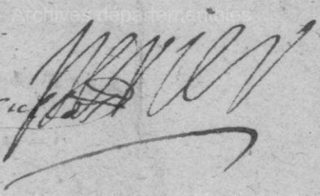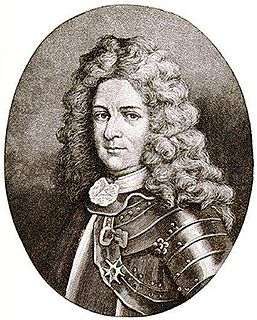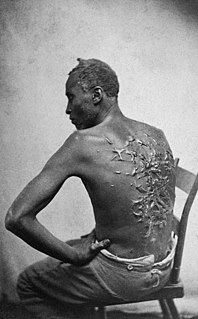Related Research Articles

The legal institution of human chattel slavery, comprising the enslavement primarily of Africans and African Americans, existed in the United States of America from its founding in 1776 until the passage of the Thirteenth Amendment in 1865. Slavery was established throughout European colonization in the Americas. From 1526, during early colonial days, it was practiced in Britain's colonies, including the Thirteen Colonies which formed the United States. Under the law, an enslaved person was treated as property and could be bought, sold, or given away. Slavery lasted in about half of U.S. states until its abolition in 1865. In the decades after the end of Reconstruction, many of slavery's economic and social functions were continued through segregation, sharecropping, and convict leasing.

In the context of the history of slavery in the Americas, free people of color were people of mixed African, European, and sometimes Native American descent who were not enslaved. They were a distinct group of free people of color in the French colonies, including Louisiana and in settlements on Caribbean islands, such as Saint-Domingue (Haiti), St. Lucia, Dominica, Guadeloupe, and Martinique. In these territories and major cities, particularly New Orleans, and those cities held by the Spanish, a substantial third class of primarily mixed-race, free people developed. These colonial societies classified mixed-race people in a variety of ways, generally related to visible features and to the proportion of African ancestry. Racial classifications were numerous in Latin America.
The Creole case was a slave revolt aboard the American slave ship Creole in November 1841, when the brig was seized by the enslaved persons onboard the ship, freeing 128 slaves who were aboard the ship when it reached Nassau in the British colony of the Bahamas where slavery was abolished. The brig was transporting enslaved people as part of the coastwise slave trade in the American South. It has been described as the "most successful slave revolt in US history". Two died in the revolt, an enslaved person and a member of the crew.

James Dunwoody Brownson De Bow was an American publisher and statistician, best known for his influential magazine De Bow's Review, who also served as superindendant of the U.S. Census from 1853 to 1855. He always spelled "De Bow" as two words.

John Austin Wharton was a lawyer, plantation owner, and Confederate general during the American Civil War. He is considered one of the Confederacy's best tactical cavalry commanders.

Étienne Perier, also known as Perier the Elder, was a French naval officer and governor of French Louisiana from 1726 to 1733. His time as governor included some notable achievements, including the construction of the first levee along the Mississippi River in 1727. In response to the Natchez Revolt, he attempted to completely destroy the Natchez people, which increased Native American hostility toward the French in the territory. Because he failed to secure the safety of the colony, Perier was recalled as governor in March 1733. He later distinguished himself as a naval officer and privateer, including during the capture of HMS Northumberland in 1744.
Marie Thérèse Coincoin, born as Coincoin, also known as Marie Thérèse dite Coincoin, and Marie Thérèse Métoyer, was a planter, slave owner, and businesswoman at the colonial Louisiana outpost of Natchitoches.

Thomas Overton Moore was an attorney and politician who was the 16th Governor of Louisiana from 1860 until 1864 during the American Civil War. Anticipating that Louisiana's Ordinance of Secession would be passed in January 1861, he ordered the state militia to seize all U.S. military posts.

Louisiana was a dominant population center in the southwest of the Confederate States of America, controlling the wealthy trade center of New Orleans, and contributing the French Creole and Cajun populations to the demographic composition of a predominantly Anglo-American country. In the antebellum period, Louisiana was a slave state, where enslaved African Americans had comprised the majority of the population during the eighteenth-century French and Spanish dominations. By the time the United States acquired the territory (1803) and Louisiana became a state (1812), the institution of slavery was entrenched. By 1860, 47% of the state's population were enslaved, though the state also had one of the largest free black populations in the United States. Much of the white population, particularly in the cities, supported slavery, while pockets of support for the U.S. and its government existed in the more rural areas.
Atlantic Creole is a term used in North America to describe a cultural group of Americans who have ancestral roots in Africa, Europe and sometimes the Caribbean. These people are culturally American and are the descendants of enslaved peoples and indentured workers during the European colonization of the Americas before 1660. Some had lived and worked in Europe or the Caribbean before coming to North America. Examples of such men included John Punch and Emanuel Driggus.

Jean Saint Malo in French, also known as Juan San Maló in Spanish, was the leader of a group of runaway enslaved Africans, known as Maroons, in Spanish Louisiana.

The Magnolia Mound Plantation House is a French Creole house constructed in 1791 near the Mississippi River in Baton Rouge, Louisiana. Many period documents refer to the plantation as Mount Magnolia. The house and several original outbuildings on the grounds of Magnolia Mound Plantation are examples of the vernacular architectural influences of early settlers from France and the West Indies. The complex is owned by the city of Baton Rouge and maintained by its Recreation Commission (BREC). It is located approximately one mile south of downtown.
During the colonial era, the Indian slavery in Alabama soon became surpassed by industrial-scale plantation slavery.

The foundation of Baton Rouge, Louisiana, dates to 1721, at the site of a bâton rouge or "red stick" Muscogee boundary marker. It became the state capital of Louisiana in 1849.
Antoine Dubuclet Jr. was the State Treasurer of Louisiana from 1868 to 1878. Before the American Civil War, Dubuclet was one of the wealthiest African Americans in the nation. After the war, he was the first person of African descent to hold the office of Louisiana treasurer. He was a Republican.

A plantation complex in the Southern United States is the built environment that was common on agricultural plantations in the American South from the 17th into the 20th century. The complex included everything from the main residence down to the pens for livestock. Southern plantations were generally self-sufficient settlements that relied on the forced labor of enslaved people.

The 1st Louisiana Native Guard was one of the first all-black regiments in the Union Army. Based in New Orleans, Louisiana, it played a prominent role in the Siege of Port Hudson. Its members included a minority of free men of color from New Orleans; most were African-American former slaves who had escaped to join the Union cause and gain freedom. A Confederate regiment by the same name served in the Louisiana militia made up entirely of free men of color.

Gordon, or "Whipped Peter", was an escaped American slave who became known as the subject of photographs documenting the extensive keloid scarring of his back from whippings received in slavery. The "scourged back" photo became one of the most widely circulated photos of the abolitionist movement during the American Civil War and remains one of the most famous photos of that era. The New York Times writer Joan Paulson Gage, noted, "The images of Wilson Chinn in chains, like the one of Gordon and his scarred back, are as disturbing today as they were in 1863. They serve as two of the earliest and most dramatic examples of how the newborn medium of photography could change the course of history."Most historians have accepted a 1863 Harper's Weekly article, which consisted of a triptych of illustrations and a narrative describing Gordon's escape from slavery and enlistment in the Union Army. However, the narrative was likely fabricated by Vincent Colyer, and Gordon and Peter are likely two different people.

Richmond Tobacco Exchange was a commodities exchange in Richmond, Virginia, where tobacco was traded.
Manuel Barcia is Chair of Global History at the University of Leeds, in the United Kingdom.
References
- 1 2 3 "People Profile |". profiles.howard.edu.
- ↑ [Kerr-Ritchie, Freedpeople in the Tobacco South, Virginia 1860-1900,], University of North Carolina Press, 1999,
- ↑ [Kerr-Ritchie, Rites of August First: Emancipation Day in the Black Atlantic World,], Louisiana State University Press, 2007,https://lsupress.org/books/detail/rites-of-august-first/
- ↑ [Kerr-Ritchie, Freedom’s Seekers: Essays on Comparative Emancipation,], Louisiana State University Press, 2014,https://lsupress.org/books/detail/freedoms-seekers/
- ↑ [Kerr-Ritchie, Rebellious Passage: The Creole Revolt and America’s Coastal Slave Trade,], Cambridge University Press, 2019,https://www.cambridge.org/core/books/rebellious-passage/04285EE7E6F691153D43C3C0EC2BE400
- ↑ "Antique Dealers | Chapel Hill, NC - Whitehall Antiques". whitehallantiques.com.
- ↑ "ELIZABETH LINDQUIST of Coldwell Banker Advantage". www.coldwellbanker.com.
-
 Quotations related to Jeffrey Kerr-Ritchie at Wikiquote
Quotations related to Jeffrey Kerr-Ritchie at Wikiquote - Howard University Faculty Page